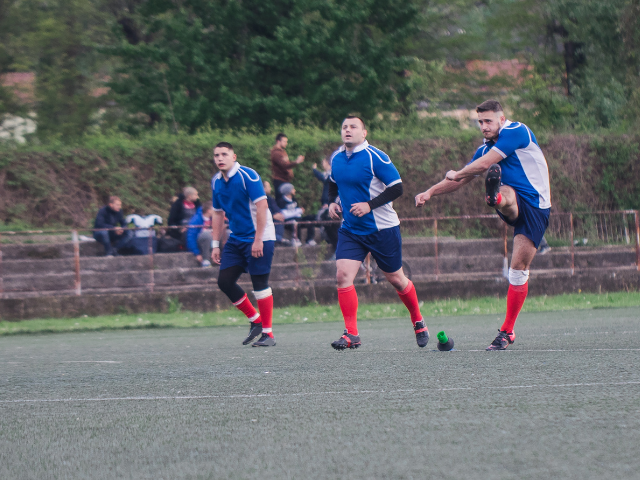Rugby sevens is the faster, more intense version of rugby union.
It’s like a regular rugby game with just seven players per team and shorter game times.
Let’s explore the basics of rugby sevens, from its rules to critical strategies.
Introduction to Rugby Sevens
Rugby sevens is a shorter, faster version of rugby union, played with seven players on each team instead of 15.
While rugby sevens has been around since the 19th century, its popularity has skyrocketed in recent years, thanks to thrilling tournaments like the Hong Kong Sevens.
World Rugby, the sport’s governing body, has pushed its global growth, and in 2016, rugby sevens were introduced to the Olympics.
Basic Rules and Gameplay
The rules of rugby sevens are straightforward and create a fast-paced game:
- Seven players per team on the field
- Two seven-minute halves (10 minutes for finals)
- One-minute half-time
- Sudden death extra time for knockout games
Scoring works just like rugby union:
- Try: 5 points
- Conversion: 2 points
- Penalty or drop goal: 3 points
The game is played on a full-sized rugby pitch, which might seem huge for just 14 players, but with players like Portia Woodman blazing down the field, the space fills up quickly.
Field of Play
The field size in rugby sevens is the same as in rugby union:
- 100 meters long
- 70 meters wide
- In-goal areas (try zones) up to 22 meters deep
Key field areas include:
- Try line: Where tries are scored
- 22-meter line: Important for kickoffs and restarts
- Halfway line: Where the game begins and restarts after scores
Starting and Restarting Play

In sevens, the game starts with a dropkick from the center of the halfway line.
After a team scores, the non-scoring team restarts with a dropkick.
The ball must travel 10 meters before it’splayed, creating exciting tactics right from the start.
Possession and Tackling
In rugby sevens, speed and space are critical.
Players focus on creating gaps, and tackling follows the same rules as rugby union—below the shoulders with wrapped arms.
Due to the open space, missing a tackle can be disastrous in sevens.
Rucks and mauls exist in sevens but happen faster and less often than in rugby union.
The game is all about keeping the ball moving and maintaining momentum.
Set Pieces
Scrums in sevens are more straightforward than in rugby union:
- Three players per team
- No pushing allowed
- The ball was put in straight
Lineouts are also smaller, with only two or three players, and quick throw-ins are expected to keep the game fast.
Penalties and Free Kicks

Common penalties in rugby sevens include:
- Offside
- High tackles
- Not releasing the ball after a tackle
Teams often take quick taps rather than kicking for points, aiming to keep the game moving fast.
Substitutions and Sin Bins
Rugby sevens uses a rolling substitution system, allowing:
- Five replacements per team
- Players can be substituted multiple times
A yellow card sends a player to the sin bin for 2 minutes (compared to 10 minutes in rugby union), while a red card sends a player off for the rest of the match. With only seven players on each team, playing with fewer than seven can be brutal.
Key Strategies and Tactics

In rugby sevens, attacking is about:
- Creating space
- Quick ball movement
- Support running
Defensive strategies often rely on sliding defenses to cover the broader spaces. Top teams like New Zealand and Fiji excel at transitioning quickly between attack and defense.
Major Rugby Sevens Tournaments
The rugby sevens calendar is packed with thrilling tournaments. Here are the biggest ones:
- HSBC World Rugby Sevens Series: This is the premier sevens competition, held annually around the world, with tournaments in locations like:
- Dubai
- Hong Kong (considered the most prestigious)
- London at Twickenham Stadium
- Olympic Games: Rugby sevens debuted at the 2016 Rio Olympics, with Fiji winning the men’s and Australia taking the women’s
- Rugby World Cup Sevens: Held every four years, it showcases the best men’s and women’s teams in the world.
Tips for Beginners
If you are new to rugby sevens, here are some beginner tips:
Fitness Requirements:
Sevens is physically demanding. YYou’llneed:
- Great endurance
- Explosive speed
- Fast recovery between sprints
Skills to Focus On:
- Ball handling: Practice passing and catching at high speeds.
- Spatial awareness: Learn to find gaps in the defense.
- One-on-one tackling: With fewer players, every tackle matters.
- Restart skills: Kicking and receiving dropkicks are crucial.
Conclusion
Rugby sevens is a fast-paced, high-scoring game that offers excitement for both players and fans. Here is a recap of the key points:
- Seven players per team
- 7-minute halves
- Full-size pitch
- Fast, simplified scrums and lineouts
- Focus on speed and space.
Whether you’re a player or a fan, Rugby Sevens delivers an exciting rugby experience with its quick pace and dynamic play. Want to give it a go?
Check out your local rugby club or watch the next round of the World Rugby Sevens Series. You might fall in love with this thrilling sport!
Don’t miss out! Check out our latest published articles for more in-depth rugby insights and tips.